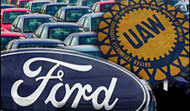
Every American should be sickened by the news that Detroit is bankrupt. What was once the envy of the world for its pioneering automobile industry has become an also-ran on the world stage.
What went wrong? In one word: unions.
At the start of the 20th century, Henry Ford recognized that innovation and a productive work force was a winning combination.
According to Ford Motor Co.’s own overview: “Early on, Ford had shocked his business and industrial contemporaries by creating the $5 workday, and then he instituted programs to teach his employees how to spend their new high wages responsibly, cut an hour off the standard workday and provided on-the-job educational facilities. He also insisted on stringently high standards of cleanliness and safety, especially for the time, in the working environment. So when labor unions began to form, he opposed them because he felt that he and his company could — and should — be responsible for meeting all the needs of his workers.”
The result was that of the Big Three, Ford was the last holdout, which led to a period of confrontation that included violence and bloodshed, including the “Battle of the Overpass” in 1937. The United Auto Workers (UAW) eventually won the right to organize the workers at Ford. The first contract was signed in 1941. Ford was later to call unionization of his plant “as his ‘greatest disappointment’ in business.”
Once unions were allowed into the Detroit auto industry, unions acquired so much power that they had a voice about which employees should be hired. Then under the leadership of UAW President Walter Reuther, the UAW engaged in “pattern bargaining” — targeting one of the Big Three during contract negotiations for terms of a new (and usually generous) contract.
James Sherk, writing for the Capital Research Center, noted that “if the automaker would not pay, the union would strike, shutting down operations, sending business to the other two companies and costing the targeted firm billions. So the target company routinely conceded to union demands. Reuther forced the other two automakers to accept contracts with similar terms. This strategy allowed the UAW to raise labor costs across the Big Three without putting any of the automakers out of business.”
Sherk continued: “This arrangement worked incredibly well for UAW members. Until the automakers were forced into bankruptcy proceedings in 2008, their labor costs (wages and benefits) exceeded $70 an hour — nearly three times as much in wages as their counterparts in U.S.-based foreign automakers. UAW members enjoyed seven weeks of paid vacation and they could retire to generous pension benefits after 30 years on the job, irrespective of age. They earned more than many Ph.D. scientists.”
But even as foreign competitors penetrated the U.S. auto market and consumers stopped buying American cars, the UAW continued to demand increases in benefits and wages for its members.
How did this work out? Even after General Motors and Chrysler filed for bankruptcy, they negotiated new contracts that substantially reduced their labor costs. And despite promises of job security, many UAW members lost their jobs, and the UAW lost its control over the supply of jobs to the auto industry.
Jobs that were safely in Michigan and Ohio were being recreated by foreign producers in South Carolina and Tennessee, both right-to-work states, free from the UAW.
By 2007, Detroit automakers were producing less than half the vehicles sold in the United States. By 2008, their financial position had so deteriorated that the recession pushed General Motors and Chrysler into bankruptcy. As a result, labor costs in the new UAW contracts are now a little higher than what non-union autoworkers make.
Robert Ditmar, writing for The Examiner, noted that despite the loss of auto sales, the unions also demanded that the Big Three provide extremely generous benefits, such as full medical coverage and a requirement that the Big Three must pay all laid-off union members up to 80 percent of their full employment wages while idle.
“Of course, once the huge pensions and benefits enjoyed by union members can be added to this mix, you have a recipe for disaster. These unsustainable costs to the automakers, when added to the overbearing benefits to the unions, have essentially priced Detroit’s vehicles out of the market. The high costs of paying the artificial wages and benefits ‘protection’ demanded by the unions have almost destroyed the City of Detroit and, to a larger extent, the economy and image of Michigan,” Ditmar wrote in 2009.
Let’s not forget the ill-conceived federal bailout that helped the UAW secure funding for retiree healthcare by giving a union trust fund an ownership stake in both GM and Chrysler.
To get a handle on where the UAW stands today, its membership has dropped 42 percent since 2004. There’s a reason. The UAW has helped kill jobs, not create them, bringing down Detroit’s economy in the process.
Exhibiting an approach to business that I subscribe to, at the start of World War II, Henry Ford stated that if it should become necessary to contribute to the war effort, the Ford Motor Co. could “under our own supervision, and without meddling by government agencies, swing into the production of a thousand airplanes an hour.” He successfully met that goal.
I’ll give Henry Ford the final words: “There is one rule for the industrialist and that is: Make the best quality of goods possible at the lowest cost possible, paying the highest wages possible.”
© 2013 Moneynews. All rights reserved.
Urgent: Should Obamacare Be Repealed? Vote Here Now!
JUL



